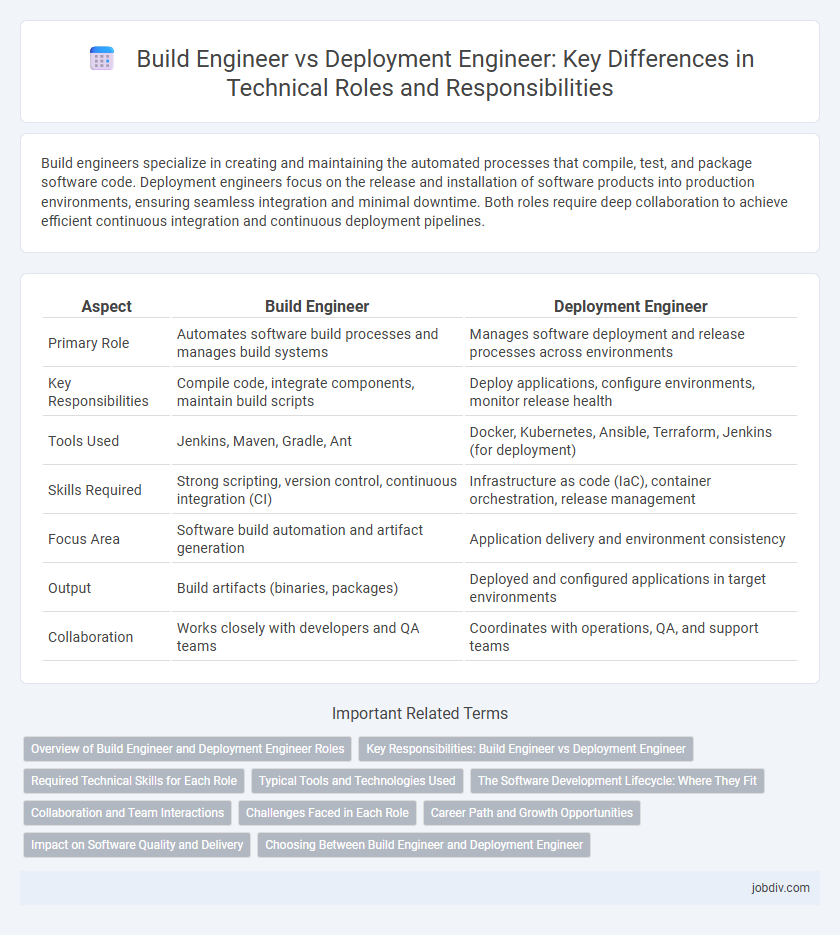Build engineers specialize in creating and maintaining the automated processes that compile, test, and package software code. Deployment engineers focus on the release and installation of software products into production environments, ensuring seamless integration and minimal downtime. Both roles require deep collaboration to achieve efficient continuous integration and continuous deployment pipelines.
Table of Comparison
| Aspect | Build Engineer | Deployment Engineer |
|---|---|---|
| Primary Role | Automates software build processes and manages build systems | Manages software deployment and release processes across environments |
| Key Responsibilities | Compile code, integrate components, maintain build scripts | Deploy applications, configure environments, monitor release health |
| Tools Used | Jenkins, Maven, Gradle, Ant | Docker, Kubernetes, Ansible, Terraform, Jenkins (for deployment) |
| Skills Required | Strong scripting, version control, continuous integration (CI) | Infrastructure as code (IaC), container orchestration, release management |
| Focus Area | Software build automation and artifact generation | Application delivery and environment consistency |
| Output | Build artifacts (binaries, packages) | Deployed and configured applications in target environments |
| Collaboration | Works closely with developers and QA teams | Coordinates with operations, QA, and support teams |
Overview of Build Engineer and Deployment Engineer Roles
Build Engineers specialize in creating and maintaining automated build processes to compile source code into executable software, ensuring version control and integration with continuous integration systems. Deployment Engineers focus on managing and automating the release of software applications to various environments, overseeing configuration management and deployment pipeline stability. Both roles collaborate closely to optimize the software delivery lifecycle, enhancing code quality and release efficiency.
Key Responsibilities: Build Engineer vs Deployment Engineer
Build Engineers primarily focus on automating and managing the software build processes, ensuring code integration, compilation, and successful creation of build artifacts. Deployment Engineers specialize in releasing, configuring, and maintaining applications within various environments, managing deployment pipelines, and ensuring system stability post-deployment. Both roles require collaboration with development and operations teams but emphasize different stages of the software delivery lifecycle.
Required Technical Skills for Each Role
Build Engineers require proficiency in CI/CD tools such as Jenkins, Bamboo, or GitLab, along with expertise in scripting languages like Python, Bash, or PowerShell to automate build processes. Deployment Engineers must have strong knowledge of configuration management tools like Ansible, Chef, or Puppet, as well as containerization platforms including Docker and Kubernetes for efficient application deployment. Both roles demand familiarity with version control systems such as Git and a deep understanding of software release cycles to ensure smooth integration and delivery.
Typical Tools and Technologies Used
Build Engineers typically use tools like Jenkins, Maven, Gradle, and Artifactory to automate the compilation, integration, and packaging of source code. Deployment Engineers often rely on technologies such as Ansible, Kubernetes, Docker, Terraform, and AWS CloudFormation to manage the provisioning, configuration, and release of applications across different environments. Both roles benefit from version control systems like Git and continuous integration platforms to ensure smooth and reliable software delivery pipelines.
The Software Development Lifecycle: Where They Fit
Build Engineers optimize the software development lifecycle by automating code compilation, integration, and version control processes to ensure consistent and reliable builds. Deployment Engineers focus on the latter stages, managing the packaging, configuration, and release of software into production environments while ensuring seamless rollouts and minimal downtime. Both roles are critical in continuous integration and continuous delivery (CI/CD) pipelines, facilitating faster and more efficient software delivery cycles.
Collaboration and Team Interactions
Build Engineers and Deployment Engineers collaborate closely to ensure seamless software delivery by integrating build processes with deployment pipelines. Build Engineers focus on automating compilation and packaging, while Deployment Engineers handle environment configurations and release management, requiring constant communication to synchronize changes and mitigate integration issues. Cross-functional teamwork enhances software quality and accelerates delivery cycles by aligning build artifacts with deployment strategies.
Challenges Faced in Each Role
Build Engineers face challenges such as managing complex build pipelines, ensuring dependency compatibility, and maintaining build automation tools for consistent, reproducible outputs. Deployment Engineers encounter difficulties in orchestrating seamless software releases, handling environment-specific configurations, and troubleshooting deployment failures to minimize downtime. Both roles require deep collaboration with development and operations teams to address integration issues and optimize the continuous integration/continuous deployment (CI/CD) process.
Career Path and Growth Opportunities
Build engineers specialize in automating and managing the software build process, focusing on continuous integration and version control systems, making them essential in software development cycles. Deployment engineers concentrate on the release and rollout of software applications, emphasizing environment configuration, scripting, and release management to ensure smooth production launches. Career growth for build engineers often advances toward DevOps or automation architect roles, while deployment engineers can evolve into release managers or infrastructure specialists, both paths offering strong prospects in evolving CI/CD pipelines and cloud-native environments.
Impact on Software Quality and Delivery
Build Engineers optimize continuous integration pipelines, ensuring code compiles correctly and automated tests run seamlessly, directly enhancing software quality by catching defects early in the development cycle. Deployment Engineers manage release processes and environment configurations, focusing on reliable and consistent software delivery to production, which minimizes downtime and deployment-related errors. The combined efforts of both roles accelerate delivery timelines while maintaining high standards of software stability and performance.
Choosing Between Build Engineer and Deployment Engineer
Choosing between a Build Engineer and a Deployment Engineer depends on the specific project requirements and team skillset; Build Engineers specialize in creating and optimizing code compilation, automation, and integration pipelines, ensuring efficient and reliable builds. Deployment Engineers focus on releasing software into production, managing deployment processes, environment configurations, and post-deployment monitoring to guarantee stability and performance. Prioritizing the role that aligns with your development lifecycle stage enhances project delivery and operational efficiency.
Build Engineer vs Deployment Engineer Infographic

 jobdiv.com
jobdiv.com